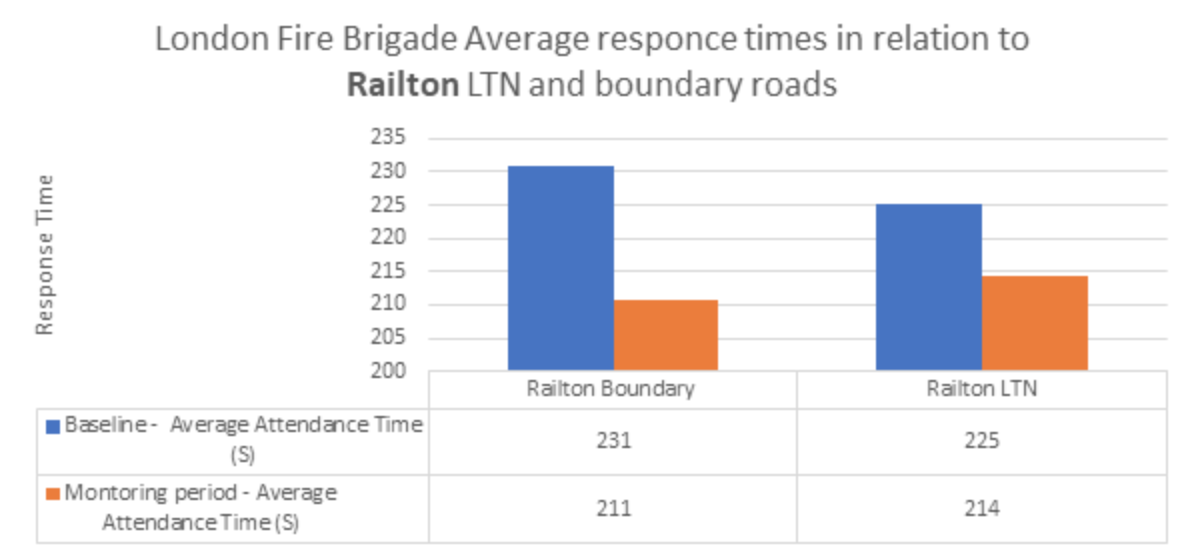Home
Emergency Services
Emergency Services
Before any Lambeth Low Traffic Neighbourhood trial was introduced the emergency services (London Ambulance Service, Metropolitan Police and London Fire Brigade) were consulted. Lambeth Council only introduced Low Traffic Neighbourhood trials where there were no objections from the emergency services.

Each emergency service operates in their own way and also collects varying amounts of data.

Academic studies looking at all LTNs and there impact of the emergency services in London suggest that there is little to no measurable impact of LTNs on fire services using publicly available data sets.
"There was no evidence that the introduction of LTNs was associated with a change in the response time for the first attending engine. The same was true for the second attending engine... This lack of any impact applied both inside LTNs and on boundary roads"- Goodman, Laverty, and Aldred (2020)
London Fire Brigade – emergency service response time analysis

Metropolitan Police Service – Low Traffic Neighbourhood statement
Data on changes to police emergency times was not readily available for inclusion in our Stage 2 analysis. The below statement is provided from the Metropolitan Police Service.
“The MPS are on the whole in favour of LTN’s for the same reasons set out by TFL, various Councils and the Government, they do however provide us with many challenges operationally not only in response mode but also through normal patrolling. We would ask where possible the following is taken into consideration.
- Ensure that emergency services are exempt, wording is important in the traffic order not to specify emergency.
- Try and use soft closures (ANPR with 619 signs) as do LAS and LFB.
- Ensure that the LTN is going to be seen in the dark, during rain foggy conditions etc.
- The MPS (along with the LAS and LFB) are not keen on lockable bollards as we don’t have keys and their use can cause delays.
- It is vital that the PCN process is more streamlined, the amount of police time wasted through this process is immensely detrimental to the public services we provide, extremely bureaucratic and not cost effective on anyone’s part. If the appropriate Borough can have a spreadsheet with all the MPS vehicle VRMs’s on and those PCN’s only get as far as our fleet services manager that would assist us greatly.”
London Ambulance Service – Low Traffic Neighbourhood statement
“London Ambulance Service (LAS) is the busiest ambulance service in the country; our focus is on achieving the best outcomes for ill and injured patients and ensuring we reach them in response times set by the government.
On the implementation of LTN schemes it is important to highlight that we support measures to improve public health by reducing traffic and encouraging walking and cycling but we know that changes to road layouts, traffic management schemes, and road closures all have the potential to impede our response to the most critically-ill people. This is why we are asking that emergency vehicle access is properly considered in all LTN schemes, by looking at ways to implement traffic management changes that avoid introducing physical barriers, like the planters and lockable bollards, in preference for automatic number plate recognition cameras (ANPR) which enable unimpeded emergency access and egress.
On 5 July 2020, LAS Chief Operating Officer formally wrote to all London Boroughs and TfL, including Lambeth, informing them of our concerns regarding hard closures and requesting that, where possible, hard closures should be avoided and camera enforced soft closures be implemented to all LTN’s for unhindered emergency vehicle access and egress, due to the potential risk hard closures could have in delaying an ambulance response and therefore impacting patient safety.
With patient safety our utmost priority, we engage regularly with traffic teams at TfL and local authorities, like Lambeth Borough Council, to discuss traffic issues and to ensure traffic schemes better reflect our operational needs. Where our response is delayed our crews have the ability to log this on our reporting system (Datix). Each report is reviewed, and if it relates to road conditions or closures, we raise the issues with TfL and the relevant borough(s) and work closely with them to adapt the schemes.
Where hard physical closures are still in place, the LAS continues to monitor for any potential impact of these closures, but would prefer the use of camera enforced soft closures in order to ensure unimpeded emergency access and egress, as previously mentioned.”

Since the Stage 1 monitoring report was published we have received 30 emails relating to Emergency Services.
Concerns noted:
This engagement phase has finished

...
